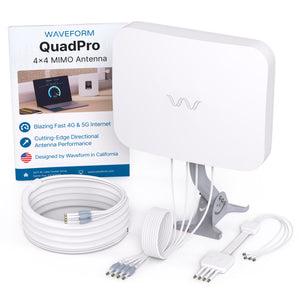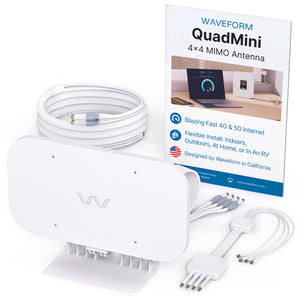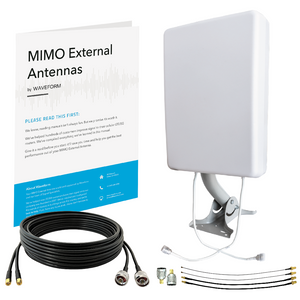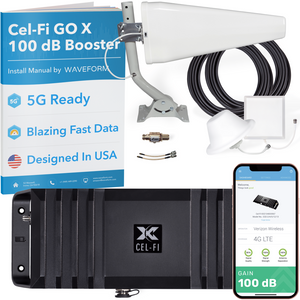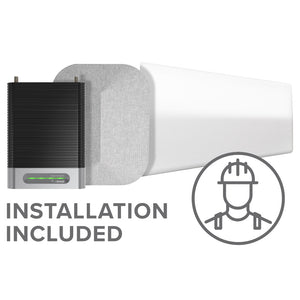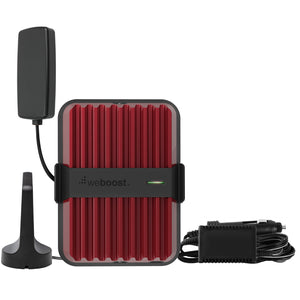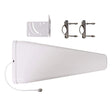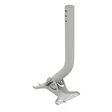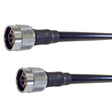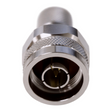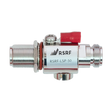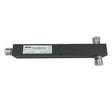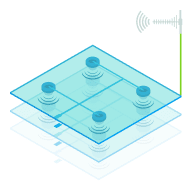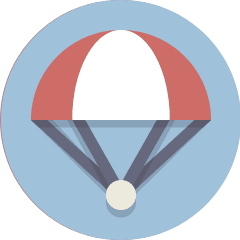The weBoost (Wilson) High Gain LPDA Antenna (311228) is a wideband log-periodic dipole array antenna offering 11-13 dBi of gain across all North American cellular frequencies.
The LPDA Antenna is a powerful directional antenna. It’s very powerful at picking up weak signal in one particular direction and it needs to be set up pointing in the direction of the cell tower. The LPDA antenna reduces signal noise, improving SINR and overall signal quality.
Features
- Works on all worldwide cellular bands for voice and data: LTE/CDMA/GSM/UMTS/AWS
- High gain antenna for WilsonPRO cellular repeater/boosters
- Designed for building exterior installation; direct at cell tower for best signal
- Rugged and waterproof for all weather operation
- Simple install kit with tilt/swivel bracket for 1.5-2 inch diameter pipe/mast
What is an LPDA antenna?
A log-periodic dipole array (LPDA) antenna is a type of directional antenna. Some manufacturers call these antennas "yagi" antennas, although technically yagi and LPDA antennas are slightly different.
Directional antennas need to be focused at the nearest cell tower. They are very powerful at picking up signal in one narrow direction. They are formed of a long central "boom" with attached metal rods called "dipole elements". The frequencies the antenna picks up depends on the length of the dipole elements.
A "yagi" antenna has dipole elements all of the same size. This means that it will only transmit and receive signals on a very narrow frequency range. Since modern cell networks use a very wide range of frequencies, this means that yagi antennas are usually only suitable for certain public safety situations, or when only one specific network needs to be boosted.
Most directional antennas on this site are log-periodic dipole array antennas. LPDA antennas have a wide range of dipole elements. The elements are spaced at intervals following a logarithmic function of the frequency, known as Σ or sigma. The different length of the dipole elements means that LPDA antennas transmit and receive signals on a wide range of cellular frequencies. The elements taper into a triangle shape. The relationship between the lengths is a function known as tau. They are wideband directional antennas that will boost signal on most North American cell carriers and so are well-suited to most cellular booster installations.
This LPDA antenna leaves the central boom and dipole arrays uncovered, but some other kinds of LPDA antennas have ABS plastic coverings.
Why use an LPDA antenna?
LPDA antennas are ideal for use in situations with low SINR. SINR, or Signal to Interference Plus Noise Ratio, is a measure of an LTE signal's quality. Clear signal has a SINR of over 10 dB, while low quality signal has a SINR of under 5 dB. SINR and signal quality is different to RSRP, or signal strength. RSRP measures signal strength and is boosted by a cellular repeater system's gain. Strong signal power is important for good coverage but despite the importance attached to dB and signal strength bars, low SINR is just as important for clear calls and reliable coverage.
Low SINR results in low throughput, poor sensitivity, poor sound quality, and a generally bad user experience. Managing SINR is vital to a good cellular booster design. High signal power (gain) is not enough to boost signal as signal quality will be poor if the noise level is too high.
A directional LPDA antenna is a great choice if signal quality is strong but noisy (low SINR). Noisy donor signal is usually caused by inter-cell interference from multiple nearby cell towers using the same frequencies. Focussing and amplifying just one of the cell towers will reduce noise and improve signal quality.
Warranty
Wilson Electronics warranties all of their home amplifiers, vehicle amplifiers, antennas, and RF components for 2 years and all of their business amplifiers for 3 years against any workmanship or material defects.
Read more about Wilson Electronics’s warranty policy via their weBoost subsidiary.



















